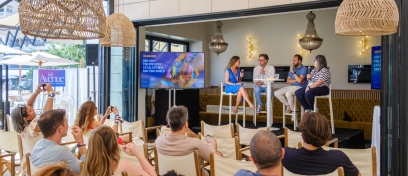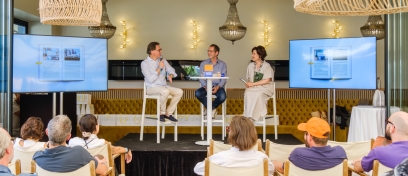For brands
Business Decision Makers have no Intention of Relinquishing Control
In this second extract from the recently released global research from JCDecaux, ‘Airports - Open for Business’, we explore the Business Decision Makers’ (BDM’s) personal relationship to business travel and the influence of airport advertising on their brand choices.
 Some travel-related brands have the opinion that their advertising has no audience at the airport, as by the time travellers reach the airport they have already made most of their travel-related decisions. This might hold true if travellers only ever took one trip in their lifetime, but that’s way off the mark for most travellers and especially untrue when it comes to the affluent and influential Business Decision Makers (BDM’s).
Some travel-related brands have the opinion that their advertising has no audience at the airport, as by the time travellers reach the airport they have already made most of their travel-related decisions. This might hold true if travellers only ever took one trip in their lifetime, but that’s way off the mark for most travellers and especially untrue when it comes to the affluent and influential Business Decision Makers (BDM’s).
With BDM’s taking around seven business flights a year, brands in sectors such as Travel, Hospitality and Technology should be tapping into the opportunities to connect with this valuable audience at a time and place where all things travel-related are particularly pertinent to them.
Contrary to popular belief, BDM’s do not leave their travel choices to their PA or someone else. Over 60% remain firmly in control of these decisions, including their choice of airline and their accommodation while away.
When BDM’s are at the airport, they are in an environment and in a mindset that makes them very attuned to messaging on anything that will make their business trips more efficient and enjoyable. Although they are keen on the benefits that come with loyalty schemes, they are also open and receptive to information and offers from competitor brands. This means advertising at the airport is a strong driver of brand consideration amongst BDM’s. Over 80% agree that they are more likely to consider a brand they see advertising at the airport.
This high dwell time provides ample opportunity to connect with BDM’s at various touchpoints as they make their way through the airport to the departure gate. Advertising creative works most effectively when it takes into account the environment, dwell time and mindset of BDM’s at each of these touchpoints.
 Airports are one of the few channels that deliver an ideal combination of long dwell times, a captive audience positively predisposed to receiving advertising messaging, large-scale formats that make a striking impression and the targeting and contextual possibilities offered by digital formats. Then consider that this can be delivered both in the airport of departure and at the airport of arrival and you have a powerful global communications channel where B2B brands can connect and engage with those who are making the decisions in business.
Airports are one of the few channels that deliver an ideal combination of long dwell times, a captive audience positively predisposed to receiving advertising messaging, large-scale formats that make a striking impression and the targeting and contextual possibilities offered by digital formats. Then consider that this can be delivered both in the airport of departure and at the airport of arrival and you have a powerful global communications channel where B2B brands can connect and engage with those who are making the decisions in business.

Find out more in Part 3 where we explore and compare the BDM’s implicit associations with B2B advertising across the main media channels.
View the Airports: Open for Business infographic here.

With BDM’s taking around seven business flights a year, brands in sectors such as Travel, Hospitality and Technology should be tapping into the opportunities to connect with this valuable audience at a time and place where all things travel-related are particularly pertinent to them.
Contrary to popular belief, BDM’s do not leave their travel choices to their PA or someone else. Over 60% remain firmly in control of these decisions, including their choice of airline and their accommodation while away.
When BDM’s are at the airport, they are in an environment and in a mindset that makes them very attuned to messaging on anything that will make their business trips more efficient and enjoyable. Although they are keen on the benefits that come with loyalty schemes, they are also open and receptive to information and offers from competitor brands. This means advertising at the airport is a strong driver of brand consideration amongst BDM’s. Over 80% agree that they are more likely to consider a brand they see advertising at the airport.

“I saw an advert for the Hilton and it looked really calming and relaxing. It made me want to change where I was staying that night.”Head of Marketing and Sales, Film Industry, US
Tailoring messaging to environment and mindset:
Although regular flyers, it may surprise some that BDM’s still arrive at the airport around two hours ahead of their scheduled departure time for short and medium haul flights and closer to 3 hours before long haul flights.This high dwell time provides ample opportunity to connect with BDM’s at various touchpoints as they make their way through the airport to the departure gate. Advertising creative works most effectively when it takes into account the environment, dwell time and mindset of BDM’s at each of these touchpoints.
Touchpoints: Pre-security:
As BDM’s are experienced travellers, they view the check-in process as routine rather than as a stressful event. They are comparatively relaxed, and as they don’t have to think about the process too much, they are more likely to be aware of their surroundings. However, they know all the hacks to get them through to departures as efficiently as possible, so do not spend any more time than necessary passing through pre-security areas.ADVERTISING CREATIVITY:
Messaging should be geared towards raising awareness rather than communicating more complex brand messaging. Repetition works well pre-security, and it is a good place to start a narrative. Creative should be kept to simple wording in these fast walking areas. Highly visual, eye-catching creative generates high recall in this area.Touchpoints: In Departures:
Once through security, BDM’s are relaxed, but they are still switched on and in work mode. They feel their time in departures is a pause, a period of still time that gives them an opportunity to think and reflect on their work. During this time, they are alert and feel receptive to information and inspiration. The majority of BDM’s say they like to walk around and see what’s going on in the departure lounge and shops, so this valuable audience is available for brands to make the connection through their advertising.
Advertising Creativity:
Higher dwell times allow for more complex brand messaging and the continuation of storytelling. Large format displays allow creatives to be visually arresting, creating impact and delivering brand authority while the capabilities of digital formats can be harnessed to deliver contextual messaging. Creatives that entertain work well within this area. The airport space is also ideal for interactive and experiential executions which are particularly effective at driving direct engagement between B2B brands and BDM’s.
“I think [your] attention span is quite high and so the advertisements catch your attention… brands which advertise in airports, they leave a very strong impression on your mind.”CEO, Management Consultancy, UAE

Find out more in Part 3 where we explore and compare the BDM’s implicit associations with B2B advertising across the main media channels.
View the Airports: Open for Business infographic here.



